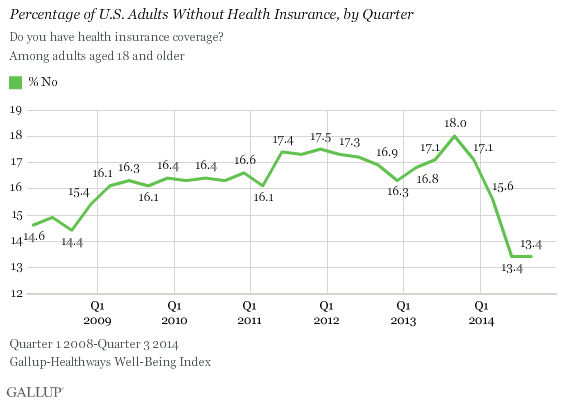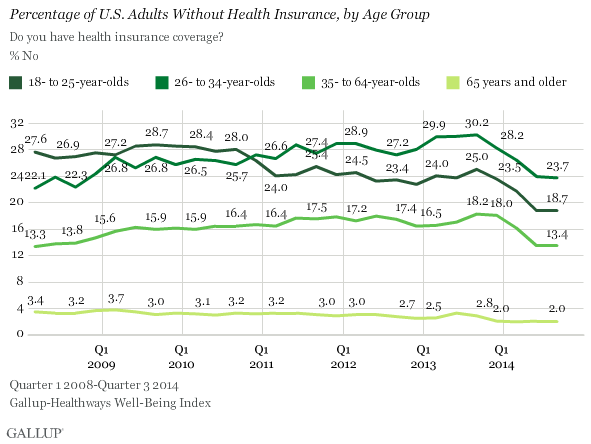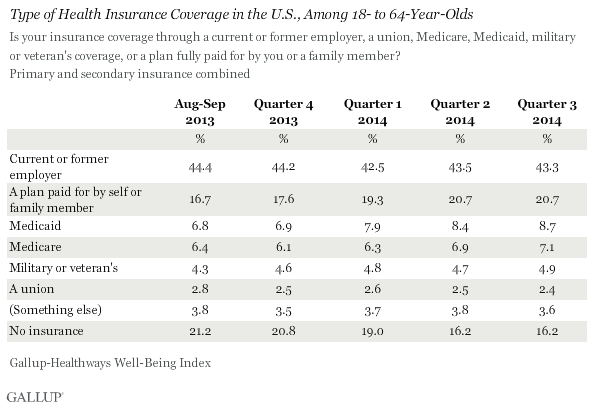WASHINGTON, D.C. -- The Affordable Care Act, commonly referred to as "Obamacare," appears to be meeting its goal of reducing the percentage of Americans without health insurance. The uninsured rate remained steady from the second quarter of 2014 at 13.4% in the third quarter. This is the lowest recorded uninsured rate since Gallup and Healthways began tracking it in 2008. The previous low point was 14.4% in the third quarter of 2008.

The uninsured rate decreased sharply after the Affordable Care Act's requirement for most Americans to have health insurance went into effect at the beginning of 2014. In fact, the uninsured rate has dropped by 3.7 percentage points since the fourth quarter of 2013, when it averaged 17.1%. The stability in the uninsured rate between the second and third quarters is not unexpected because the health insurance exchanges were not taking new enrollments during that time. The last enrollment period ended in April, and the new enrollment period will begin in November.
The third quarter results are based on more than 44,900 interviews with U.S. adults from July 1 to Sept. 30, 2014, as part of the Gallup-Healthways Well-Being Index. Gallup and Healthways ask 500 U.S. adults whether they have health insurance every night, allowing for precise and ongoing measurement of the percentage of Americans who lack health insurance.
Uninsured Rate Declines Most in the West
Since the end of 2013, the uninsured rate has dropped most in the West -- 4.8 points, from 18.7% to 13.9%. In the Midwest and South, the uninsured rates have also dropped significantly, 3.9 and 3.4 points, respectively. Even with these declines, the South continues to maintain the highest uninsured population among the four regions, with 17% uninsured. The Northeast has also had a steady decline in its uninsured rate since the end of 2013, dropping from 12.5% to 9.8%. The uninsured rates in the Northeast and Midwest are the lowest recorded of any region since the first quarter of 2013.

Uninsured Rates Stable Across Age Groups in Third Quarter
The uninsured rates across all age groups were essentially unchanged in the third quarter compared with the second quarter. But since the fourth quarter of 2013 -- before the "individual mandate" took effect -- the uninsured rate has fallen by nearly five points within each age group younger than 65.
Americans aged 26 to 34 remain the most likely to be uninsured, at 23.7%. Younger adults aged 18 to 25 were the most likely to lack health insurance until winter 2010, shortly after the provision allowing adults younger than 26 to stay on their parents' health plan took effect.

Seniors aged 65 or older are the least likely to be uninsured (2%) because they are eligible for Medicare.
Many Adults Still Covered by Employer or Self-Funded Plans
More 18- to 64-year-olds say their health insurance is through a current or former employer (43.3%) than any other type of health insurance coverage, unchanged from the second quarter. One in five Americans younger than 65 say they are covered by a self-funded plan (20.7%), which is four points higher than the rate at the end of the third quarter in 2013 (16.7%) and likely the result of many more Americans obtaining individual plans through a government health insurance exchange.
There has also been a slight increase in the number of 18- to 64-year-olds with Medicaid, Medicare, and military or veteran's insurance. It is not surprising to see an increase in those with Medicaid because of the Medicaid expansion.

Implications
The Affordable Care Act seems to be accomplishing its goal of providing more Americans with health insurance, as the uninsured rate is at its lowest point in Gallup's nearly seven-year trend. From the end of 2013 to the closing of the open enrollment period in April this year, the uninsured rate dropped 3.7 points. The uninsured rate then leveled off after the enrollment period ended and can be expected to remain steady until after plans purchased through the upcoming open enrollment period go into effect on Jan. 1, 2015.
With the open enrollment period for 2015 coverage beginning on Nov. 15, 2014, the U.S. Department of Health & Human Services (HHS) is gearing up to enroll those still uninsured. In the first enrollment period, 10.3 million Americans successfully signed up for health coverage through the ACA health insurance marketplace. However, there are several reasons why further closing the health insurance gap may be more challenging this year. Those who did not sign up for coverage during the last open enrollment period may be harder to reach, or simply more resistant to getting health insurance. Additionally, the open enrollment period will be much shorter in 2015, leaving less time for people to sign up. And public opinion toward the healthcare law still tilts negative, which could affect the enrollment process and percentage of uninsured in 2015.
Still, there are some positive signs that the uninsured rate might fall more after the next open enrollment period ends. HHS plans to alter its marketing strategy ahead of the open enrollment period to focus on the financial assistance available to enrollees and the steep increase in the fine for not having health insurance: for 2015, $325 per person for the year or 2% of an individual's yearly household income, whichever is greater. Gallup previously found that higher fines would compel more uninsured Americans to sign up.
The uninsured rate could also drop further as more states look to expand Medicaid. Twenty-seven states, plus the District of Columbia, have already implemented Medicaid expansion through the ACA, which Gallup found to be a major factor in declining uninsured rates. Pennsylvania will implement the Medicaid expansion effective January 2015, and several other states have approved Section 1115 waivers for expansion -- Arkansas, Iowa, and Michigan -- which gives the secretary of HHS authority to approve experimental, pilot, or demonstration projects that promote the objectives of Medicaid and the Children's Health Insurance Program.
Editor's Note: The analysis of regional data reflect a change from the original version.
Survey Methods
Results for this Gallup poll are based on telephone interviews conducted as part of the Gallup-Healthways Well-Being Index survey July 1-September 30, 2014, with a random sample of 44,998 adults, aged 18 and older, living in all 50 U.S. states and the District of Columbia.
For results based on the total sample of national adults, the margin of sampling error is ±1 percentage points at the 95% confidence level.
Interviews are conducted with respondents on landline telephones and cellular phones, with interviews conducted in Spanish for respondents who are primarily Spanish-speaking. Each sample of national adults includes a minimum quota of 50% cellphone respondents and 50% landline respondents, with additional minimum quotas by time zone within region. Landline and cellular telephone numbers are selected using random-digit-dial methods. Landline respondents are chosen at random within each household on the basis of which member had the most recent birthday.
Samples are weighted to correct for unequal selection probability, nonresponse, and double coverage of landline and cell users in the two sampling frames. They are also weighted to match the national demographics of gender, age, race, Hispanic ethnicity, education, region, population density, and phone status (cellphone only/landline only/both, and cellphone mostly). Demographic weighting targets are based on the most recent Current Population Survey figures for the aged 18 and older U.S. population. Phone status targets are based on the most recent National Health Interview Survey. Population density targets are based on the most recent U.S. census. All reported margins of sampling error include the computed design effects for weighting.
In addition to sampling error, question wording and practical difficulties in conducting surveys can introduce error or bias into the findings of public opinion polls.
For more details on Gallup's polling methodology, visit www.gallup.com.
